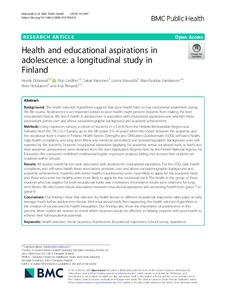Health and educational aspirations in adolescence: A longitudinal study in Finland
Henrik Dobewall; Pirjo Lindfors; Sakari Karvonen; Leena Koivusilta; Mari-Pauliina Vainikainen; Risto Hotulainen; Arja Rimpelä
https://urn.fi/URN:NBN:fi-fe2021042822825
Tiivistelmä
Background
The health selection hypothesis suggests that poor health leads to low educational attainment during the life course. Adolescence is an important period as poor health might prevent students from making the best educational choices. We test if health in adolescence is associated with educational aspirations and whether these associations persist over and above sociodemographic background and academic achievement.
Methods
Using classroom surveys, a cohort of students (n = 5.614) from the Helsinki Metropolitan Region was followed from the 7th (12–13 years,) up to the 9th grade (15–16 years) when the choice between the academic and the vocational track is made in Finland. Health factors (Strengths and Difficulties Questionnaire (SDQ), self-rated health, daily health complaints, and long-term illness and medicine prescribed) and sociodemographic background were self-reported by the students. Students’ educational aspirations (applying for academic versus vocational track, or both) and their academic achievement were obtained from the Joint Application Registry held by the Finnish National Agency for Education. We conducted multilevel multinomial logistic regression analyses, taking into account that students are clustered within schools.
Results
All studied health factors were associated with adolescents’ educational aspirations. For the SDQ, daily health complaints, and self-rated health these associations persisted over and above sociodemographic background and academic achievement. Students with better health in adolescence were more likely to apply for the academic track, and those who were less healthy were more likely to apply for the vocational track. The health in the group of those students who had applied for both educational tracks was in between. Inconsistent results were observed for long-term illness. We also found robust associations between educational aspirations and worsening health from grade 7 to grade 9.
Conclusions
Our findings show that selection by health factors to different educational trajectories takes place at early teenage much before adolescents choose their educational track, thus supporting the health selection hypothesis in the creation of socioeconomic health inequalities. Our findings also show the importance of adolescence in this process. More studies are needed to reveal which measures would be effective in helping students with poor health to achieve their full educational potential.
Kokoelmat
- Rinnakkaistallenteet [27094]
